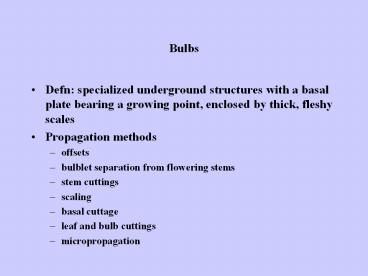Bulbs - PowerPoint PPT Presentation
Title:
Bulbs
Description:
Bulbs Defn: specialized underground structures with a basal plate bearing a growing point, enclosed by thick, fleshy scales Propagation methods – PowerPoint PPT presentation
Number of Views:409
Avg rating:3.0/5.0
Title: Bulbs
1
Bulbs
- Defn specialized underground structures with a
basal plate bearing a growing point, enclosed by
thick, fleshy scales - Propagation methods
- offsets
- bulblet separation from flowering stems
- stem cuttings
- scaling
- basal cuttage
- leaf and bulb cuttings
- micropropagation
2
Propagation of bulbs by offsets
- Used extensively for tulips and daffodils
- tulips - features
- bulbs are dug in the summer
- offsets are separated, graded for size
- stored, replanted the same fall
- offsets usu. require 2-3 growing seasons to
achieve flowering size
3
Photo showing various shapes, sizes and colors of
tulip flowers (Rix 1981)
4
Fig. 15-1. Structure of tulip, a tunicate bulb,
with parts labelled.
5
Developing offset
6
Offset propagation of Narcissus (daffodils)
- flowering bulb continues growth from the center
(as opposed to tulips) each year - propagation method is similar(to tulips), by
separation of the offset or split - harvested bulbs are graded 1st yr (round or
single-nose, 2nd yr (double nose), and 3rd yr
(mother bulbs)
7
Photo showing various flower colors of daffodil
(Rix 1981)
8
Well-developed offsets
Double-nosed bulb
9
Amaryllis (Hippeastrum)
10
Bulblet separation from flowering stems
- useful for propagation of Easter lilies
- method
- underground bulblets pulled from flowering stems
- planted in late fall (Pacific Northwest)
- dug the following Sept., graded and replanted
- 2 yrs to commercial bulbs
11
Fig. 15-5. The flowering stem of Easter lily.
12
Main flowering bulb
Offsets attached to the stem of the flower stalk
13
Stem cuttings of bulbs
- used for Easter lilies
- cuttings are made from flowering stems (after
flowering), then stuck in moist medium - bulblets form in leaf axils
- some lilies also form bulbils in leaf axils of
the flowering stem
14
(No Transcript)
15
(No Transcript)
16
Bulb scaling
- useful for a wide variety of lily species
- scales are separated from the bulb (individual
scales separate readily from this nontunicate
bulb) - adventitious bulblets form at the base of each
scale - bulblets are usu. vernalized for sev. weeks, then
planted - scaling can also be done by tissue culture for
multiplying virus-indexed stock
17
Fig. 15-4. The structure of the Easter lily
bulb, with parts labelled.
18
(No Transcript)
19
(No Transcript)
20
(No Transcript)
21
Basal cuttage
- useful for hyacinths
- basal plate is removed (scooped) or scored
(to remove the growing point - adventitious bulblets develop from the base of
exposed bulb scales
22
Photo of the hyacinth flowering shoot (Harrison
1967)
23
(No Transcript)
24
Figure of a hyacinth bulb with bulblets forming
after bulb scoring (Clark and Toogood 1990)
25
Photos showing bulb scoring and scooping (Free
1957)
26
Leaf cuttings of bulb species
- useful for grape hyacinths (Muscari botryoides),
blood lily (Haemanthus coccineus), common
hyacinths (Hyacinthus orientalis) - similar to leaf cuttings of other herbaceous
plants, except a bulblet forms at the base of the
leaf cutting
27
Bulb cuttings
- useful for Narcissus, Hippeastrum (Amaryllis)
- called bulb chipping or fractional scale-stem
cuttage - mature bulb is cut into 8-10 vertical sections,
then further divided by cutting between every 3rd
or 4th concentric scale, through the basal plate - twin scaling is a variation on this method
28
Fig. 15-12. Twin-scaling of Narcissus.
29
Micropropagation of bulb species
- useful for iris (bulbous), hyacinth, and
(increasingly) Narcissus, Hippeastrum, and Lilium
(e.g., 12 million annually in the Netherlands) - increase is by shoot multiplication, bulblet
induction on scales followed by bulblet division,
or bulblet induction on flower scapes
30
Photo showing micropropagation of bulbous iris
(Zimmerman et al. 1986)
31
Fig. 15-10. Micropropagation of bulbous iris and
hyacinth.
32
Propagation of corms
- useful for gladiolus and freesia
- corm the swollen base of a stem axis, enclosed
by dry, scale-like leaves - propagation methods
- separation of offset corms
- cormels (miniature corms between old and new
corms) - corm division (retaining a bud with each section)
- micropropagation (both glads and freesias)
33
Fig. 15-13 and 15-14. Photo and diagrams of
gladiolus corms, with parts labelled.
34
Photo showing gladiolus micropropagation
(Zimmerman et al. 1986)
35
Recap
- Bulb propagation
- Offsets (tulip and daffodil)
- Bulblet separation from flowering stems (Easter
lily) - Stem cuttings (lily)
- Scaling (lily)
- Basal cuttage - scoring and scooping (hyacinth)
- Leaf and bulb cuttings - e.g., bulb chipping,
twin scaling (narcissus, amaryllis) - Micropropagation (iris, hyacinth, narcissus,
amaryllis, lily)
36
Recap - contin.
- Corm propagation (gladiolus, freesia)
- Separation of offset corms
- Separation of cormels
- Corm division
- Micropropagation
- And, from the text What is the advantage of
growing tulips for bulb production in the Pacific
Northwest (of the U.S.)? What happens if the
bulbs are dug too early or if warm weather causes
early maturation?































